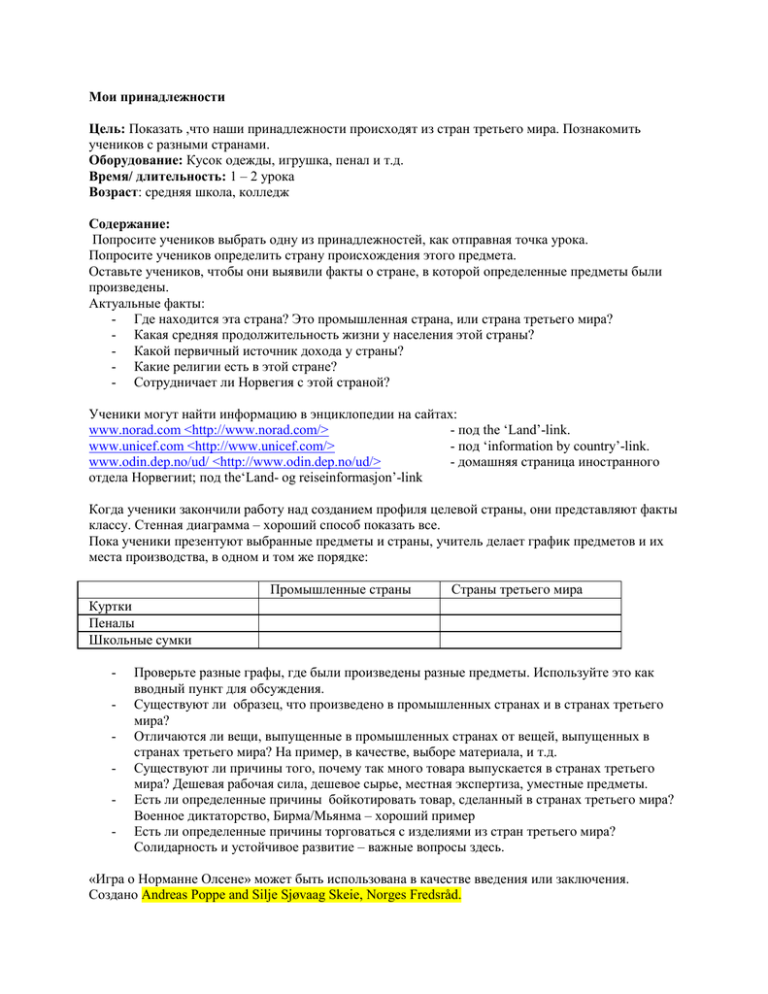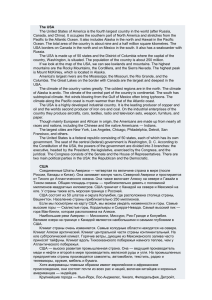Мои принадлежности - Education for Peace
advertisement

Мои принадлежности Цель: Показать ,что наши принадлежности происходят из стран третьего мира. Познакомить учеников с разными странами. Оборудование: Кусок одежды, игрушка, пенал и т.д. Время/ длительность: 1 – 2 урока Возраст: средняя школа, колледж Содержание: Попросите учеников выбрать одну из принадлежностей, как отправная точка урока. Попросите учеников определить страну происхождения этого предмета. Оставьте учеников, чтобы они выявили факты о стране, в которой определенные предметы были произведены. Актуальные факты: - Где находится эта страна? Это промышленная страна, или страна третьего мира? - Какая средняя продолжительность жизни у населения этой страны? - Какой первичный источник дохода у страны? - Какие религии есть в этой стране? - Сотрудничает ли Норвегия с этой страной? Ученики могут найти информацию в энциклопедии на сайтах: www.norad.com <http://www.norad.com/> - под the ‘Land’-link. www.unicef.com <http://www.unicef.com/> - под ‘information by country’-link. www.odin.dep.no/ud/ <http://www.odin.dep.no/ud/> - домашняя страница иностранного отдела Норвегииt; под the‘Land- og reiseinformasjon’-link Когда ученики закончили работу над созданием профиля целевой страны, они представляют факты классу. Стенная диаграмма – хороший способ показать все. Пока ученики презентуют выбранные предметы и страны, учитель делает график предметов и их места производства, в одном и том же порядке: Промышленные страны Страны третьего мира Куртки Пеналы Школьные сумки - Проверьте разные графы, где были произведены разные предметы. Используйте это как вводный пункт для обсуждения. Существуют ли образец, что произведено в промышленных странах и в странах третьего мира? Отличаются ли вещи, выпущенные в промышленных странах от вещей, выпущенных в странах третьего мира? На пример, в качестве, выборе материала, и т.д. Существуют ли причины того, почему так много товара выпускается в странах третьего мира? Дешевая рабочая сила, дешевое сырье, местная экспертиза, уместные предметы. Есть ли определенные причины бойкотировать товар, сделанный в странах третьего мира? Военное диктаторство, Бирма/Мьянма – хороший пример Есть ли определенные причины торговаться с изделиями из стран третьего мира? Солидарность и устойчивое развитие – важные вопросы здесь. «Игра о Норманне Олсене» может быть использована в качестве введения или заключения. Создано Andreas Poppe and Silje Sjøvaag Skeie, Norges Fredsråd. MY BELONGINGS Goal: Show that our belongings are likely to originate from third world countries. Make the students acquainted with the different countries. Equipment: Piece of clothing, a toy, a pencil case, etc. Time/duration: Age: 1 -2 lessons. Middle school, secondary, college Content: Ask the students pick one of their belongings as a starting point for the lesson. Ask the students to determine the items origin country. Leave the students to dig out facts about the country where the particular items are being produced. Relevant facts are: - Where is the country located? Is it an industrial- or third world country? - What is the populations average lifespan? - What is its primary source of income? - What are the gender-specifics of that country? - Which religions are present? - Does Norway have any cooperation with that particular country? The students may find info in an encyclopaedia or on the web: www.norad.com <http://www.norad.com/> www.unicef.com <http://www.unicef.com/> www.odin.dep.no/ud/ <http://www.odin.dep.no/ud/> department; under the - Under the ‘Land’-link. - Under ‘information by country’-link. - Homepage of the Norwegian foreign ‘Land- og reiseinformasjon’-link When the students are done making a ‘profile’ on their target countries, they present the facts for the class. A wall chart might be a good way to display it. While the students present their chosen items and countries, the teacher makes a graph on what is produced where, in a similar way: Industrial countries Third world countries Outdoor jackets Pencil cases School bags Check the different boxes where the different items are produced. Use this as an entry point for classdiscussion. Subjects to be discussed can be: Are there any pattern in what is produced in industrial countries and what is produced in third world countries? Will things produced in industrial countries differ from those produced in third world countries? For instance in quality, colours, choice of materials, etc.? Are there any reason that so many different items are produced in third world countries? Cheap labour, cheap raw materials, local expertise, etc., are relevant subjects. Are there particular reasons to boycott products made in third world countries? The military dictatorship Burma/Myanmar is a good example. Are there particular reasons to trade with products from third world countries? Solidarity and steady development are important issues here. "The play about Normann Olsen" may very well be used connected to this task, either as an introduction or as closure. Made by Andreas Poppe and Silje Sjøvaag Skeie, Norges Fredsråd.
